|
Jul
18
2022
|
|
Posted 3 years 152 days ago ago by Admin
|
|

VIEW FEATURED VIDEO
Las Vegas is Spanish for "the meadows,” as the area featured abundant wild grasses, as well as desert spring waters needed by westward travelers. Today, there’s plenty more in Las Vegas to attract travelers. It’s now the 26th most populous city in the nation, a top-three destination for business conventions and the No. 1 choice for fun by many.
With 2.2 million permanent residents and more than 40 million visitors per year, Clark County, Nevada, and the Las Vegas metro area have become an iconic destination for family vacationers, gamers, and eco-tourists who use the city as a jumping off point for desert excursions. The self-proclaimed “Entertainment Capital of the World” is famous for its luxurious and large casino-hotels.
A pivotal year for the city was 1931: Nevada legalized casino gambling and reduced residency requirements for divorces.Construction on Hoover Dam began that year and the project helped Las Vegas survive the Great Depression. A decade later Las Vegas Army Airfield (later renamed Nellis Air Force Base) opened. It’s now home to the United States Air Force Thunderbirds aerobatic team.
Las Vegas Metro Police Dept. Aviation
Another aviation team that bolsters the city and its surroundings is the Las Vegas Metro Police Department (LVMPD) Air Support/Search and Rescue Section. Director Steve Morris, says that the unit’s mission is clear: Provide air support to all sections of the department and any concurrent jurisdictions within Clark County. Their law enforcement helicopter operations date back to 1969 when the City of Las Vegas Police purchased and operated a Hughes 300. In 1973, the Las Vegas PD and the Clark County Sheriff’s Office merged and became the unit it is today. In the decades since then the program has flown Hughes 300, MD 500 (C,D,E), and two retired Air Force Bell HH-1H Hueys. Today, the unit flies one Airbus H145 in search and rescue configuration and three MD 530FFs in LE configuration.

Proactive Patrol
Most LVMPD flight operations involve patrolling the city skies of Las Vegas and the surrounding county. Director Morris’ strategy though, is more of a proactive policing approach rather than a reactive one. “We do active helicopter patrol, which is being a police car in the sky, and many times arriving first on a crime call,” says Morris. Many law enforcement units in the U.S. are more reactive in that they wait until ground units need air support and are called out to assist. The LVMPD unit believes that their approach of patrolling up to 12 hours per day provides many benefits not only to ground units working the streets, but to citizens as well.
“SUSPECT APPREHENSION AND LIABILITY REDUCTION IS WHAT WE DO ON PATROL.”
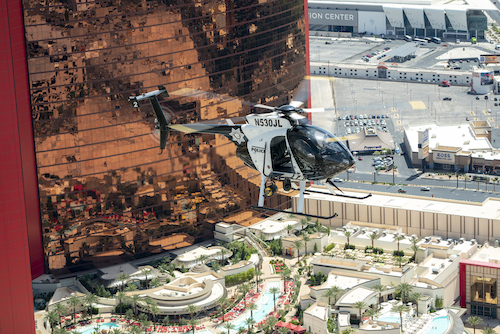
“The main reason we do so much patrol is for three reasons: suppress crime, assist apprehension of offenders running from ground units, and reduce liability for the agency by being the command-and-control platform during incidents,” said Morris. He further indicated that the unit tracks how often they are the first police asset on scene and it’s more often than one would think. On any given day, the air patrol units can be first on scene as often as 40% of the time as compared to being the second or third asset to arrive.
Tactical Tech
Currently, the unit uses a fleet of MD530Fs for its patrol missions. There are plans to introduce an Airbus H125 into the fleet in the near future.The MD530FFs are a platform for some of the most sophisticated law enforcement equipment in the industry. For example, the aircraft and tactical flight officer (TFO) utilize the Churchill ARS 700 georeferenced moving map system with augmented reality display.
Additionally, the aircraft are configured with the L3Harris WESCAM MX-10 camera/sensor. The MX-10 is a smaller, capable sensor system that incorporates field-proven, fully active 4-axis stabilization with multi-spectral sensors that provide imaging over multiple wavebands, ensuring both day and night imaging capability over a wide range of weather conditions. Morris reflects, “Even if for some reason a criminal does happen to get away from our ground units during pursuit, if the helicopter is on scene and using the MX-10, the video quality is so high, the footage is often used at a later point to put the suspect at the scene and help get an indictment.”
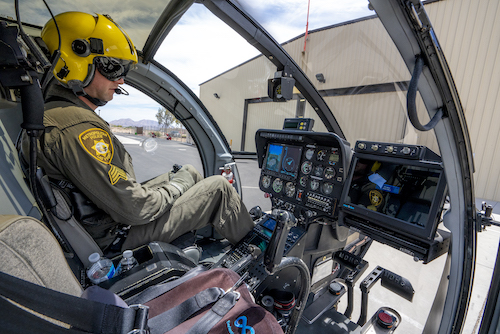
With the combination of the Churchill system and the L3 Wescam MX-10 camera/sensor, the amount of data available to the TFO is significant and not only assists in arrests, but also helps drive safer tactical decisions when guiding ground units.
SAR And Special Missions
For search and rescue operations and special missions, the Airbus H145 is the platform of choice. Given that the service area for the air unit is 7,560 square miles (larger than New Jersey) the air unit needed a helicopter that was not only fast and could cover a lot of ground, but also a solid platform for a variety of missions like hoisting, sling loading, and inserting tactical teams into hostile environments. “In short, the Airbus H145 checked all the boxes that we needed to check for a rescue helicopter and a tactical team deployment helicopter operating in high, hot, and heavy conditions.”
“IN SHORT, THE AIRBUS H145 CHECKED ALL THE BOXES WE NEEDED TO CHECK.”
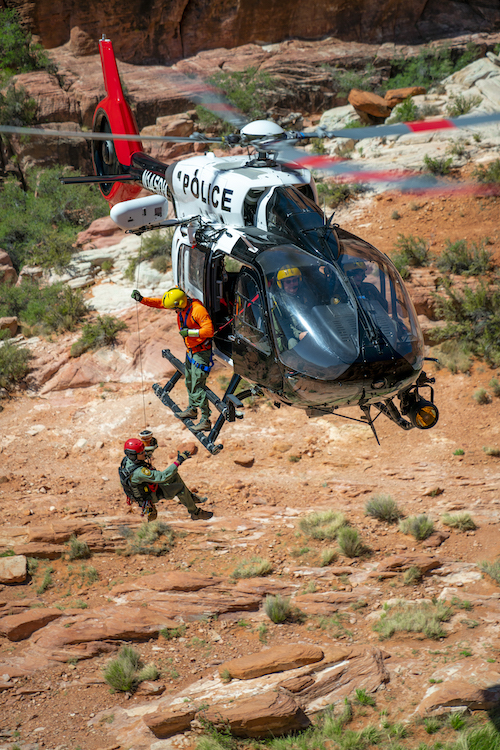
In addition to twin-engine performance and the fenestron tail rotor, which enhances safety in tight operating environments, the H145 is equipped with a Goodrich hoist and the lauded Helionix cockpit.
Helionix, which has surpassed the fleetwide benchmark of 500,000 hours, is the avionics solution developed in-house by Airbus Helicopters designed to provide greater operational safety and mission flexibility in an intuitive, pilot-friendly cockpit environment. It offers an innovative cockpit layout with two-to-four multi-function screens designed to improve pilots’ situational awareness. In addition to the avionics suite are a GPS navigation/communication system and traffic advisory notification, along with a mission system incorporating a digital map, terrain avoidance capabilities, and synthetic vision cockpit technology.
Further contributing to a reduction of the pilot’s workload and enhanced safety is the Helionix four-axis autopilot. Helionix also lowers helicopter maintenance costs by monitoring more than a thousand parameters in real time, allowing operators to monitor system trends and anticipate unscheduled maintenance operations. “The Helionix system with the four-axis autopilot and ground track hover control is unmatched in the industry,” said Morris.
Safety Through People And Policy
From a management perspective, the leadership does not believe that its ability to be successful hinges entirely upon equipment. Although the right equipment for the mission improves operational outcomes, the real difference is in the unit’s maintenance, its people, and a philosophy that governs operations through leadership and risk mitigation.
Due to the high operational tempo, maintenance plays a critical role in the unit’s ability to maintain readiness for day-to-day operations. The maintenance team is made up of four A&P mechanics. Among these four is the maintenance supervisor who holds an FAA Inspection Authorization. With the unit flying anywhere between 4,300 and 5,000 hours per year, the maintenance team is performing a 100-hour inspection approximately every eight days in addition to other scheduled and unscheduled maintenance. Director Morris noted, “I put maintenance at the top of importance. If the helicopters are not flying, we will not be able to fulfill our mission and support the needs of the community.”
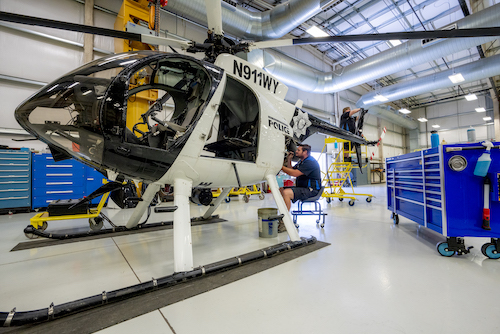
Operationally, the unit has a total of 16 pilots who are dual-qualified to function as a TFO, as well as being NVG qualified. Additionally, there’s one other TFO that’s pulled from another agency. When it comes to the rescue side of the house, in addition to the pilots, there’s a large cadre of personnel who perform the rescues. In-house, there are seven SAR officers and one sergeant, which makes up the core team of rescue techs. There are also 47 highly trained volunteers from the local professional community, which can be drawn upon to supplement the core team of specialists on an as-needed basis. Morris indicated that when it comes to keeping this large team in a constant state of operational readiness, the key is standardization in training among personnel.
Given that all the pilot staff comes from within the ranks of the organization, flight training is built into the program. There’s a dedicated MD 530F training helicopter and six flight instructors on staff who make it their business to make professional pilots out of police officers. There is usually two hours to three hours of training per day prepping future pilots to not only perform the job, but to take and pass FAA checkrides for certification.
One big focus of the director and the chief pilot is focusing on risk management within the unit using communications, policy, and standardized training to drive safety outcomes. Morris points out that it's not enough to tell your pilots and crews to “be safe.” It really does not mean a whole lot if the agency’s risk mitigation policy and procedures don’t promote safety.
Regarding flight standardization, the chief pilot has been tasked with working with the flight instructors to ensure they are teaching the same thing across the pilot teams. The combination of CFI meetings and Airbus/MD factory training ensures that the unit’s pilots are standardized.
“WITH PILOTS AND COPS THERE CAN BE A LOT OF EGO, SO I TRY AND REMOVE EGO DECISIONS AT THE HIGHEST LEVEL”
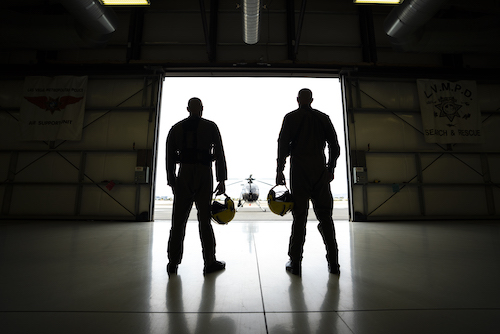
“With pilots and cops there can be a lot of ego, so I try to remove ego decisions at the very highest level, so I don’t have young cops who are pilots making ego decisions that can get them into bad situations.”
As the commander of the unit, Morris indicates that the organization will not settle for anything mediocre. He said that they desire to have the best equipment, training, pilots, TFOs, mechanics, and crews. “Simply the Best,” a 1980s hit sung by Las Vegas draw Tina Turner is played at officer graduation ceremonies at the LVMPD academy.
From personnel to training and equipment, it seems that LVMPD’s Air Support/Search and Rescue Section is intent on delivering “simply the best” service to the citizens and visitors to Clark County, Nevada.
VIEW VIDEO FEATURE
READ MORE MAY/JUNE ISSUE
READ MORE ROTORCRAFT PRO
WATCH ROTORCRAFT PRO YOUTUBE CHANNEL
You can also find us on
Instagram - https://www.instagram.com/rotorcraftpro/
Facebook - https://www.facebook.com/rotorcraftpro/
Twitter - https://twitter.com/justhelicopters